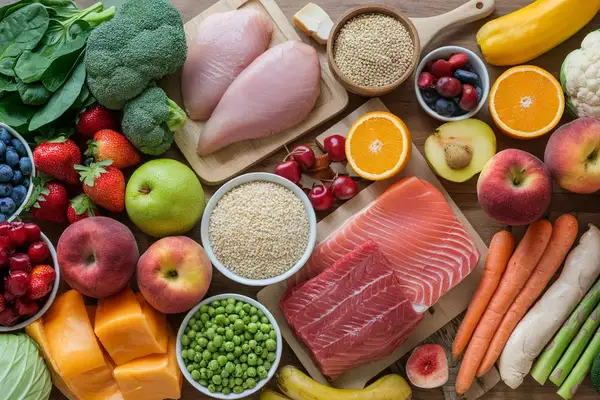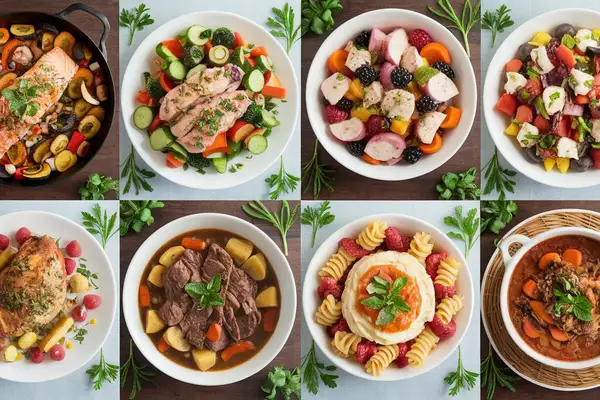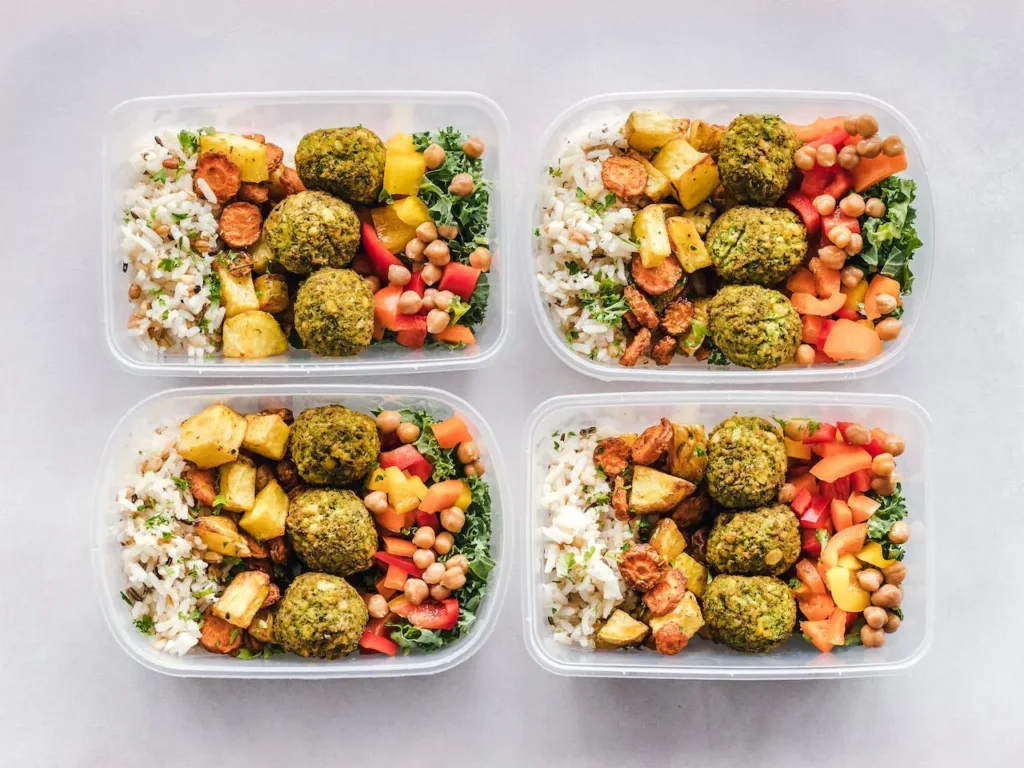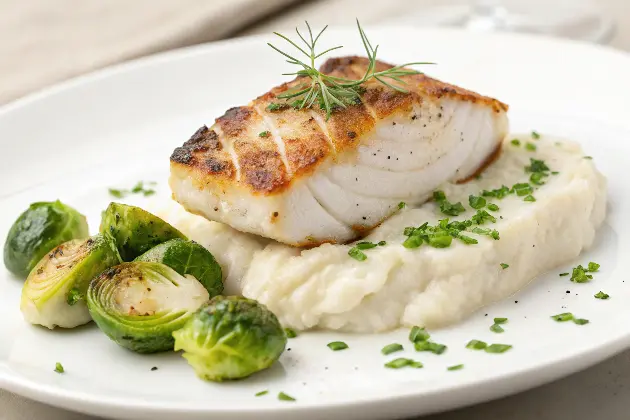7 Day Vegetarian Meal Plan: High Protein and Low In Carbs
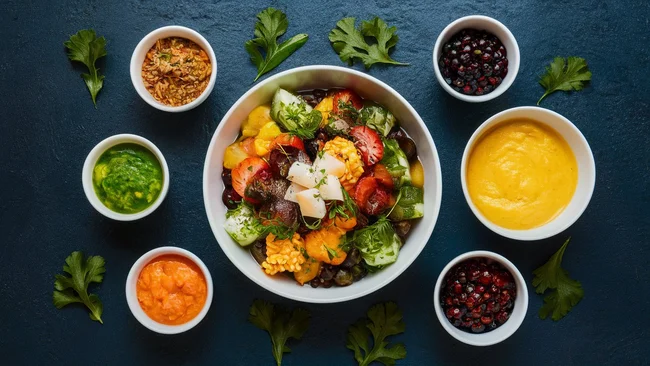
- Vegetarian Food List
- 7 Day Vegetarian Meal Plan, High Protein Low Carbs
- Easy High Protein Vegetarian Meals For Breakfast
- Easy High Protein Vegetarian Meals for Lunch
- Easy High Protein Vegetarian Meals for Dinner
- Easy High Protein Vegetarian Snacks
- Health Benefits of a Vegetarian Diet
- Risks of a Vegetarian Diet
- Vegetarian Meal Planning Tips
- Conclusion
- FAQs
- Citations
This post may contain affiliate links, meaning I may earn a commission if you make a purchase, at no extra cost to you. I only recommend products I trust. Thank you for your support.
A vegetarian diet is a dietary pattern that primarily focuses on plant-based foods while excluding or limiting the consumption of animal-derived products such as meat, poultry, and seafood.
It is characterized by the consumption of fruits, vegetables, grains, legumes, nuts, and seeds, and may include dairy and eggs depending on the specific type of vegetarian diet. The types of a vegetarian diet include:
- Vegan Diet: The strictest form of vegetarian diet, excluding all animal products and by-products, such as meat, dairy, eggs, and honey.
- Ovo-Vegetarian Diet: Excludes meat, poultry, seafood, and dairy but includes eggs and egg-containing foods.
- Lacto-Vegetarian Diet: Excludes meat, poultry, seafood, and eggs but includes dairy products like milk, cheese, yogurt, and butter.
- Lacto-Ovo-Vegetarian Diet: Involves the elimination of all meat, poultry, and seafood but includes dairy (Lacto) and eggs (Ovo).
- Pescatarian Diet: Excludes meat and poultry but includes fish and other seafood. It also prioritizes plant foods alongside seafood, making it easier to meet protein, iodine, and omega-3 requirements.
- Flexitarian Diet: Emphasizes the inclusion of a predominantly plant-based diet but allows for occasional consumption of meat and other animal products in moderation.
This article includes a comprehensive 7-day vegetarian meal plan, high protein vegetarian meals, various vegetarian dishes, low carb vegetarian meals, easy vegetarian recipes, and a vegetarian food list.
Vegetarian Food List
To embark on your 7-day vegetarian meal plan, it’s essential to familiarize yourself with the wide array of nutritious and versatile vegetarian food options.
Here’s a detailed and complete Vegetarian Food List for you:
1. Fruits
- Apples
- Bananas
- Oranges
- Berries (Strawberries, Blueberries, Raspberries, etc.)
- Grapes
- Mangoes
- Pineapples
- Watermelons
2. Vegetables
- Spinach
- Broccoli
- Carrots
- Bell Peppers
- Tomatoes
- Cucumbers
- Cauliflower
- Zucchini
- Potatoes
- Sweet Potatoes
3. Grains
- Quinoa
- Brown Rice
- Oats
- Barley
- Buckwheat
- Whole Wheat Bread
- Whole Wheat Pasta
4. Legumes
- Lentils
- Chickpeas
- Black Beans
- Kidney Beans
- Soybeans
- Peas
5. Nuts and Seeds
- Almonds
- Walnuts
- Cashews
- Pistachios
- Chia Seeds
- Flaxseeds
- Sunflower Seeds
- Pumpkin Seeds
6. Dairy and Alternatives
- Milk (Almond Milk, Soy Milk, Oat Milk, etc.)
- Yogurt (Coconut Yogurt, Soy Yogurt, etc.)
- Cheese (Plant-Based Cheese)
- Butter (Plant-Based Butter)
7. Protein Sources
- Tofu
- Tempeh
- Seitan
- Edamame
- Quorn Products
8. Plant-Based Oils
- Olive Oil
- Coconut Oil
- Avocado Oil
9. Herbs and Spices
- Basil
- Cilantro
- Mint
- Oregano
- Rosemary
- Turmeric
- Cumin
- Paprika
- Chili Flakes
10. Beverages
- Green Tea
- Herbal Tea
- Freshly Squeezed Juices
- Coconut Water
- Plant-Based Protein Shakes
7 Day Vegetarian Meal Plan, High Protein Low Carbs
This 7 day vegetarian meal plan is high in protein and low in carbs focussing on incorporating a variety of plant-based protein sources while minimizing carbohydrate intake.
Each day includes a balanced mix of easy high protein vegetarian dishes that align with the specific dietary requirements for a vegetarian diet.
Here’s a complete 7-day vegetarian meal plan with high protein meals and easy low carb vegetarian meals:
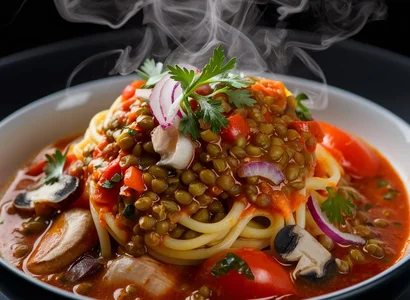
Day 1
Breakfast:
- Greek Yogurt Bowl: Greek yogurt with chia seeds, flaxseeds, and a handful of berries (blueberries, strawberries).
Lunch:
- Spinach and Lentil Salad: Spinach, cooked lentils, cherry tomatoes, cucumber, bell peppers, and a lemon-olive oil dressing.
- Chickpea and Vegetable Tagine with Couscous: Chickpeas, carrots, zucchini, and bell peppers cooked in a Moroccan-spiced tomato sauce, served with a side of couscous.
Dinner:
- Lentil and Mushroom Bolognese: Lentils and mushrooms cooked in a rich tomato sauce, served over zucchini noodles.
- Greek Salad with Tofu: Romaine lettuce, cucumber, cherry tomatoes, red onions, olives, and tofu cubes, dressed with olive oil and lemon juice.
Snacks:
- Celery Sticks with Almond Butter: Celery sticks served with a small portion of almond butter.
- Almonds: A handful of almonds.
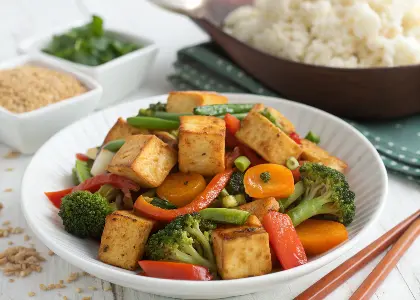
Day 2
Breakfast:
- Green Smoothie: Spinach, kale, avocado, almond milk, and a scoop of plant-based protein powder.
Lunch:
- Grilled Tofu with Steamed Broccoli: Grilled tofu seasoned with turmeric and cumin, served with steamed broccoli and a side of quinoa.
Dinner:
- Chickpea and Vegetable Stir-fry: Chickpeas, zucchini, bell peppers, and carrots stir-fried in olive oil and seasoned with paprika and chili flakes.
- Cauliflower Rice with Tempeh: Cauliflower rice with sautéed tempeh, seasoned with cumin and oregano.
Snacks:
- Pumpkin Seeds: A handful of pumpkin seeds.
- Greek Yogurt with Flaxseeds: A small bowl of Greek yogurt with a sprinkle of flaxseeds.
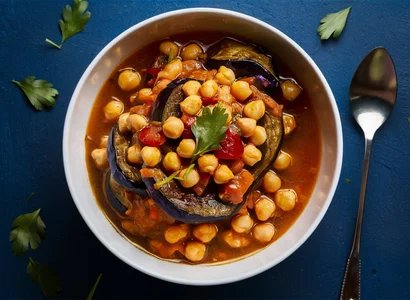
Day 3
Breakfast:
- Tofu Scramble: Tofu scrambled with spinach, tomatoes, and bell peppers, seasoned with turmeric and cumin.
Lunch:
- Vegetarian Chili: A hearty chili made with black beans, kidney beans, tomatoes, bell peppers, and spices, served with a side of cauliflower rice.
- Broccoli and Quinoa Salad: Steamed broccoli, quinoa, cherry tomatoes, and a lemon-tahini dressing.
Dinner:
- Eggplant and Chickpea Stew: Eggplant and chickpeas cooked in a tomato-based sauce with rosemary and basil.
Snacks:
- Walnuts: A handful of walnuts.
- Cucumber Slices with Hummus: Fresh cucumber slices served with hummus.
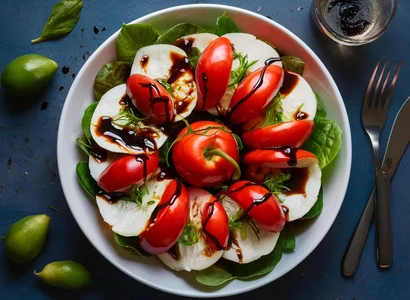
Day 4
Breakfast:
- Berry Smoothie: Mixed berries, almond milk, and a scoop of plant-based protein powder.
Lunch:
- Black Bean Salad: Black beans, corn, tomatoes, red onions, cilantro, and a lime-cumin dressing.
- Caprese Salad with Balsamic Glaze: Fresh mozzarella, tomatoes, and basil drizzled with balsamic glaze.
Dinner:
- Stuffed Bell Peppers: Bell peppers stuffed with a mixture of quinoa, black beans, tomatoes, and spices.
- Eggplant and Lentil Moussaka: Layers of eggplant, lentils, and tomatoes, topped with a creamy plant-based béchamel sauce.
Snacks:
- Sunflower Seeds: A handful of sunflower seeds.
- Greek Yogurt with Chia Seeds: A small bowl of Greek yogurt with a sprinkle of chia seeds.
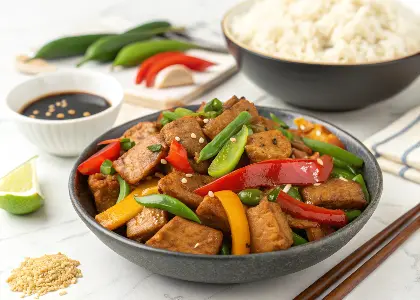
Day 5
Breakfast:
- Avocado Toast on Whole Wheat Bread: Mashed avocado on whole wheat toast, topped with cherry tomatoes and a sprinkle of paprika.
Lunch:
- Pesto Ravioli with Spinach & Tomatoes: Ravioli stuffed with pesto, served with sautéed spinach and cherry tomatoes.
- Zucchini Noodles with Pesto: Zucchini noodles with a basil and almond pesto sauce.
Dinner:
- Seitan Stir-fry: Seitan stir-fried with broccoli, bell peppers, and mushrooms in a soy sauce and ginger dressing.
Snacks:
- Cashews: A handful of cashews.
- Carrot Sticks with Hummus: Fresh carrot sticks served with hummus.
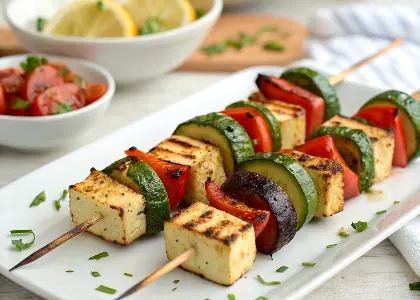
Day 6
Breakfast:
- Oatmeal with Almonds and Berries: Cooked oats topped with almonds and a mix of fresh berries.
Lunch:
- Tofu and Vegetable Kebabs: Skewers of tofu, bell peppers, zucchini, and cherry tomatoes, grilled and served with a side of quinoa.
- Lentil Soup: Hearty lentil soup with carrots, celery, tomatoes, and spinach.
Dinner:
- Grilled Portobello Mushrooms: Grilled portobello mushrooms served with a side of quinoa and steamed broccoli.
- Vegan Lentil Shepherd’s Pie: Lentil base topped with mashed sweet potatoes, baked until golden.
Snacks:
- Pistachios: A handful of pistachios.
- Bell Pepper Slices with Guacamole: Fresh bell pepper slices served with guacamole.
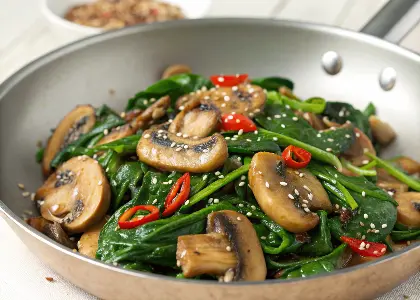
Day 7
Breakfast:
- Chia Pudding: Chia seeds soaked in almond milk, topped with fresh berries and a sprinkle of flaxseeds.
Lunch:
- Spinach and Ricotta Stuffed Shells: Large pasta shells stuffed with spinach and ricotta, baked in a marinara sauce.
- Edamame and Quinoa Salad: Edamame, quinoa, cherry tomatoes, cucumbers, and a sesame-soy dressing.
Dinner:
- Vegan Quinoa Paella: Quinoa cooked with saffron, bell peppers, green beans, peas, and tomatoes.
- Mushroom and Spinach Stir-fry: Mushrooms and spinach stir-fried with garlic and olive oil, served with a side of steamed cauliflower rice.
Snacks:
- Pumpkin Seeds: A handful of pumpkin seeds.
- Cucumber Slices with Almond Butter: Fresh cucumber slices served with almond butter.
Easy High Protein Vegetarian Meals For Breakfast
- Quinoa Breakfast Bowl: A hearty mix of quinoa, almond milk, and nuts, topped with fresh fruits for a protein-packed morning meal.
- Chia Seed Pudding: A simple blend of chia seeds, almond milk, and Greek yogurt, topped with nuts and berries for a high-protein, make-ahead breakfast.
- Tofu Scramble: A savory mix of crumbled tofu, sautéed vegetables, and spices, providing a substantial protein boost to kick start your day.
- Egg and Vegetable Muffins: Whisked eggs combined with a variety of vegetables, baked into muffin tins for a convenient, protein-rich breakfast on the go.
- Peanut Butter Banana Smoothie: A creamy blend of peanut butter, banana, and Greek yogurt for a delicious and protein-packed morning shake.
- Protein-Packed Oatmeal: Oats cooked with plant-based milk and topped with nuts, seeds, and a dollop of nut butter for a satisfying, high-protein breakfast.
- Greek Yogurt Parfait: Layers of Greek yogurt, granola, and fresh berries for a quick, protein-rich breakfast option.
Easy High Protein Vegetarian Meals for Lunch
- Mediterranean Chickpea Salad: A refreshing mix of chickpeas, cucumbers, tomatoes, and feta cheese, drizzled with a tangy vinaigrette for a protein-rich lunch.
- Tofu and Vegetable Stir-Fry: Cubed tofu stir-fried with an assortment of colorful vegetables in a savory sauce, served over brown rice or quinoa for a satisfying lunch.
- Lentil and Quinoa Salad: A hearty combination of cooked quinoa, lentils, and mixed greens, tossed with a zesty dressing for a protein-packed salad.
- Black Bean Quesadillas: Smashed black beans, cheese, and veggies sandwiched between whole wheat tortillas, then grilled to perfection for a filling and high-protein lunch.
- Tempeh Lettuce Wraps: Marinated tempeh wrapped in crisp lettuce leaves, along with shredded carrots and a flavorful sauce, offering a light yet protein-rich lunch option.
- Greek Yogurt Chicken Salad: A creamy chicken salad made with Greek yogurt, celery, and grapes, served on whole grain bread for a protein-packed sandwich.
- Protein-Packed Buddha Bowl: A vibrant bowl featuring a mix of roasted vegetables, quinoa, and a dollop of hummus for a filling and nutritious lunch.
Easy High Protein Vegetarian Meals for Dinner
- Vegetarian Chili with Toast: A hearty, protein-rich chili made with beans and topped with shredded cheese, served with a side of whole grain toast for a comforting dinner.
- General Tso’s Tofu over Quinoa: Crispy tofu in a tangy sauce, served over fluffy quinoa for a flavorful, protein-packed dinner option.
- One-Pot Chili Mac: A comforting blend of macaroni, beans, and cheese in a chili-infused sauce for a satisfying, high-protein dinner.
- Chili-Poached Egg Skillet with Toast: A protein-rich skillet featuring poached eggs in a flavorful chili sauce, served with a side of whole grain toast for a hearty dinner.
- Broccoli Cheddar Egg Muffins: Fluffy egg muffins loaded with broccoli and cheddar cheese, providing a substantial protein boost for a hassle-free dinner.
- Peanut Butter Oatmeal: Creamy oatmeal cooked with plant-based milk, peanut butter, and topped with nuts for a simple yet protein-packed dinner option.
Easy High Protein Vegetarian Snacks
- Roasted Chickpeas: Crispy, seasoned chickpeas roasted to perfection for a protein-packed snack.
- Greek Yogurt with Berries: Creamy Greek yogurt topped with fresh berries for a quick and protein-rich snack.
- Almond Butter and Apple Slices: Crisp apple slices paired with creamy almond butter for a satisfying protein-rich snack.
- Trail Mix: A mix of nuts, seeds, and dried fruits for a convenient and protein-packed snack on the go.
- Hummus and Veggie Sticks: Fresh, crunchy veggies served with creamy hummus for a nutritious and protein-rich snack.
- Cottage Cheese with Pineapple: Creamy cottage cheese paired with sweet pineapple for a protein-rich and refreshing snack.
- Protein Smoothie: A blend of plant-based protein powder, almond milk, and fruits for a refreshing and protein-packed snack option.
Health Benefits of a Vegetarian Diet
Embracing a vegetarian lifestyle offers a multitude of benefits for your health and the environment. These include:
- Improved Heart Health: Vegetarian diets have been linked to a lower risk of heart disease, as they are typically low in saturated fat and high in fiber, antioxidants, and beneficial plant compounds.
- Reduced Risk of Chronic Diseases: Vegetarian diets have been associated with a lower incidence of type 2 diabetes and other chronic health conditions.
- Enhanced Gut Health: The high fiber content of a vegetarian diet supports a diverse and thriving gut microbiome, which is essential for overall well-being.
- Weight Management: Vegetarian diets tend to be lower in calories and higher in nutrient density, making them an effective approach for maintaining a healthy weight.
- Cancer Prevention: Several studies suggest that vegetarian diets are associated with a reduced risk of certain types of cancer, particularly colorectal cancer.
- Lower Blood Pressure: The high potassium content in fruits and vegetables, along with a lower intake of sodium and saturated fats, helps maintain healthy blood pressure levels.
Risks of a Vegetarian Diet
While a well-planned vegetarian diet can be highly nutritious, there are a few potential risks to be aware of. These include:
- Vitamin B12 Deficiency: Vitamin B12 is primarily found in animal-based foods, so vegetarians and vegans may need to supplement or consume fortified foods to maintain adequate levels.
- Iron Deficiency: The absorption of iron from plant-based sources can be lower than from animal-based sources, so vegetarians may need to pay close attention to their iron intake.
- Omega-3 Fatty Acid Deficiency: Vegetarians may need to include plant-based sources of omega-3 fatty acids, such as walnuts, flaxseeds, or algae supplements, to ensure adequate intake.
- Protein Deficiency: While it is possible to meet your protein needs on a vegetarian diet, it may require more planning and a varied intake of protein-rich plant foods.
- Calcium Deficiency: Vegetarians should ensure they consume adequate calcium-rich foods, such as leafy greens, fortified plant-based milk, or dairy products (for non-vegan vegetarians).
Vegetarian Meal Planning Tips
To make the most of your 7-day vegetarian meal plan, consider these helpful tips:
- Prioritize Protein: Ensure that each meal includes a good source of plant-based protein, such as legumes, tofu, tempeh, or seitan, to support your overall health and muscle maintenance.
- Prioritize Colorful Vegetables: Opt for a wide range of colorful vegetables to ensure a broad spectrum of vitamins, minerals, and antioxidants.
- Plan Ahead: Engage in meal prepping and batch cooking to save time and have healthy, ready-to-go options on hand throughout the week.
- Supplement as Needed: If you have any concerns about nutrient deficiencies, consult with a healthcare professional or registered dietitian to determine if supplementation is necessary.
- Seek Nutrient-Rich Alternatives: Use fortified plant-based milk, nutritional yeast, and omega-3-rich flaxseed or chia seeds to supplement key nutrients often found in animal products.
- Stay Hydrated: Don’t forget to drink plenty of water and consider incorporating herbal teas and naturally flavored water to maintain hydration throughout the day.
Conclusion
Embarking on a vegetarian diet can be an incredibly rewarding experience, filled with a diverse array of delicious and nutritious vegetarian meals.
By following this comprehensive 7-day vegetarian meal plan, and incorporating the vegetarian foods or high protein vegetarian meals mentioned in this article, you’ll be well on your way to a healthier life.
Remember, the key to success is to approach this transition with an open mind, a willingness to experiment, and a commitment to nourishing your body with a variety of plant based foods.
Embrace the opportunity to explore new flavors, discover new and easy vegetarian recipes and easy low carb vegetarian meals, and cultivate a deeper appreciation for the abundance of vegetarian dishes available.
Remember, there is no one-size-fits-all approach to vegetarian eating. What works for one person may not work for another.
Be patient with yourself, and don’t be afraid to seek guidance from a registered dietitian or healthcare professional if you have any concerns or questions.
Ultimately, the 7 day vegetarian meal plan is designed to inspire and empower you to take charge of your health and make informed choices about the foods you consume.
- Is the Paleo diet healthy?
- Dukan diet for beginners
- BRAT diet for diarrhea recipes
- Keto diet recipes easy
- Kelly Clarkson’s weight loss diet
- Easy vegetarian breakfast ideas
- 20 Christmas party buffet food ideas
- 40 Mediterranean diet breakfast ideas
- Gluten-free meal plan
- 20 easy meal prep ideas
- 14 moringa health benefits for men
- 7-day diet plan for weight loss
FAQs
What is the difference between vegan and vegetarian?
The main difference between vegan and vegetarian diets is that vegetarians still consume dairy products and eggs, while vegans avoid all animal-derived products, including meat, poultry, fish, dairy, and eggs.
Are eggs vegetarian?
Yes, eggs are considered vegetarian. In fact, lacto-ovo and ovo vegetarians can eat eggs. Lacto-ovo vegetarians avoid meat, poultry, and fish but consume dairy and eggs, while ovo-vegetarians avoid all animal products except eggs.
What is the most famous vegetarian dish?
One of the most famous and widely recognized vegetarian dishes is the Indian curry dish, Chana Masala. This flavorful chickpea-based curry is a staple in many vegetarian and vegan diets.
Are vegetarian meals healthy?
Yes, vegetarian meals can be very healthy. A well-balanced vegetarian meal plan that includes a variety of fruits, vegetables, whole grains, legumes, nuts, and seeds can provide all the necessary nutrients for a healthy lifestyle.
Studies have shown that vegetarian diets can be associated with lower risks of heart disease, high blood pressure, type 2 diabetes, and certain types of cancer.
Can a vegetarian drink milk?
Yes, lacto-vegetarians and lacto-ovo vegetarians can drink milk. Lacto-ovo vegetarians avoid meat, fish, and poultry but consume both dairy and eggs, while lacto-vegetarians exclude meat, poultry, fish, and eggs but can include dairy products.
Can vegetarians eat white rice?
Yes, vegetarians can eat white rice. White rice is a staple food that is widely consumed in vegetarian diets.
It serves as a versatile and energy-rich carbohydrate source that can be paired with a variety of vegetarian-friendly dishes, including vegetables, legumes, tofu, tempeh, and plant-based curries.
Can vegetarians eat pizza?
Yes, vegetarians can enjoy pizza as long as they order it without meat toppings. Vegetarian pizza options often include toppings like vegetables, mushrooms, and plant-based cheeses.
Citations
- Dinu, M., Abbate, R., Gensini, G. F., Casini, A., & Sofi, F. (2017). Vegetarian, vegan diets and multiple health outcomes: A systematic review with meta-analysis of observational studies. Critical reviews in food science and nutrition, 57(17), 3640-3649.
- Melina, V., Craig, W., & Levin, S. (2016). Position of the Academy of Nutrition and Dietetics: vegetarian diets. Journal of the Academy of Nutrition and Dietetics, 116(12), 1970-1980.
- Tuso, P. J., Ismail, M. H., Ha, B. P., & Bartolotto, C. (2013). Nutritional update for physicians: plant-based diets. The Permanente Journal, 17(2), 61.
- Huang, R. Y., Huang, C. C., Hu, F. B., & Chavarro, J. E. (2016). Vegetarian diets and weight reduction: a meta-analysis of randomized controlled trials. Journal of general internal medicine, 31(1), 109-116.
- Kahleova H, Matoulek M, Malinska H, Oliyarnik O, Kazdova L, Neskudla T, Skoch A, Hajek M, Hill M, Kahle M, Pelikanova T. Vegetarian diet improves insulin resistance and oxidative stress markers more than conventional diet in subjects with Type 2 diabetes. Diabet Med. 2011 May;28(5):549-59. doi: 10.1111/j.1464-5491.2010.03209.x. PMID: 21480966; PMCID: PMC3427880.
Disclaimer: The vegetarian meal plan provided above is intended for informational and educational purposes only. It is not a substitute for professional medical advice, diagnosis, or treatment.
Always seek the advice of your physician or other qualified health provider with any questions you may have regarding a medical condition or dietary restrictions.
